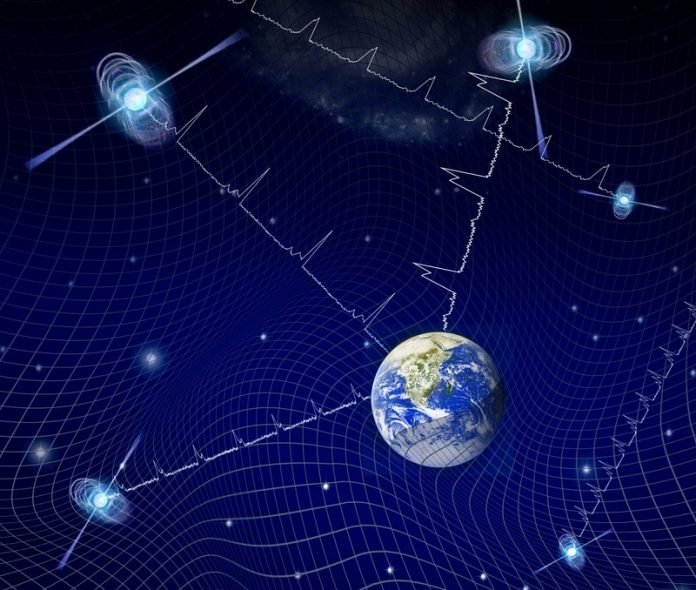
An international team of astronomers reports they have found the first faint, low-frequency whispers that may be gravitational waves from gigantic, colliding black holes in distant galaxies.
The findings were obtained from more than 12.5 years of data collected from the national radio telescopes at Green Bank, West Virginia, and the recently collapsed dish at the Arecibo Observatory, in Arecibo, Puerto Rico.
The research was announced Jan. 11 at a press conference at the American Astronomical Society’s national meeting, held online due to the COVID-19 pandemic.
The press conference highlighted the research, “The NANOGrav 12.5-year Data Set: Search for an Isotropic Stochastic Gravitational-wave Background,” published in The Astrophysical Journal Letters.
The astronomers are all participants in the North American Nanohertz Observatory for Gravitational Waves (NANOGrav) project, which uses pulsars – rapidly spinning dense stars – that act as wave detectors and cosmic timekeepers.
Merging gargantuan black holes create gravitational waves that can send ripples through space-time and affect a pulsar’s timekeeping regularity – ultimately indicating that Earth’s position in the universe may have slightly shifted.
“We must be clear: We are not yet claiming to have detected gravitational waves,” said Shami Chatterjee, Ph.D. ’03, a Cornell principal research scientist in the College of Arts and Sciences’ (A&S) Department of Astronomy.
“We have detected a signal that is consistent with the existence of gravitational waves, but we can’t prove that quite yet. We think this is the tip of the iceberg, but we have to actually demonstrate it to our own satisfaction.”
To get a sense of the size of these gravitational waves, recall the wave detection by the Laser Interferometer Gravitational-Wave Observatory (LIGO) in early 2016, when scientists caught two black holes merging.
The merger set off kilohertz waves that were hundreds of kilometers in length, small enough to allow Earth-based detectors to capture them from kilometer-wide, land-based sensors.
That finding confirmed a major prediction of Albert Einstein’s 1915 general theory of relativity.
In the NANOGrav case, gigantic black holes are in the process of merging.
“The masses we’re talking about are the giant black holes that are in the centers of galaxies,” said James Cordes, the George Feldstein Professor of Astronomy (A&S).
“They are a billion times the mass of the sun. They’re monsters.”
And these monsters are generating nanohertz-scale gravitational quavers that are light-years in length, said Cordes. Thus, astronomers enlist pulsars to help detect these waves.
The paper notes that 47 pulsars were studied to gather this data; currently the astronomers are using 80 pulsars.
Cordes said the plan is for the project’s astronomers to use about 200 pulsars, once they secure telescope time on other radio telescopes – to replace the time lost at the Arecibo Observatory, which recently collapsed.
Written by Blaine Friedlander.



